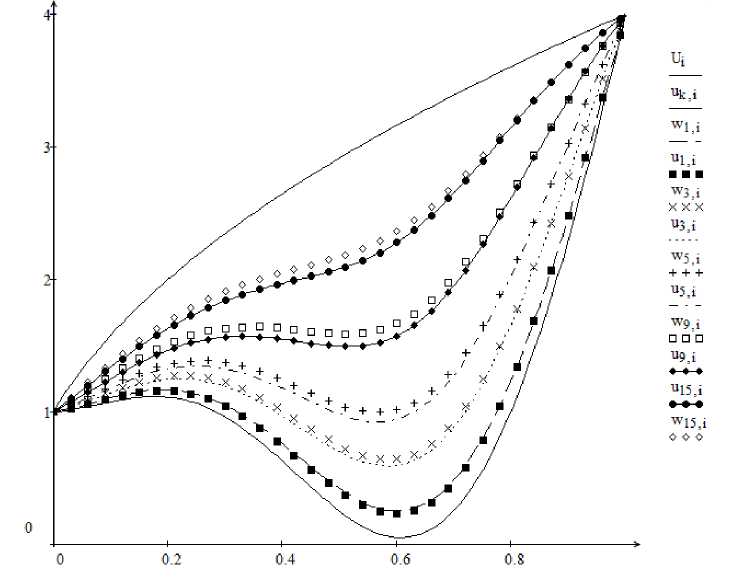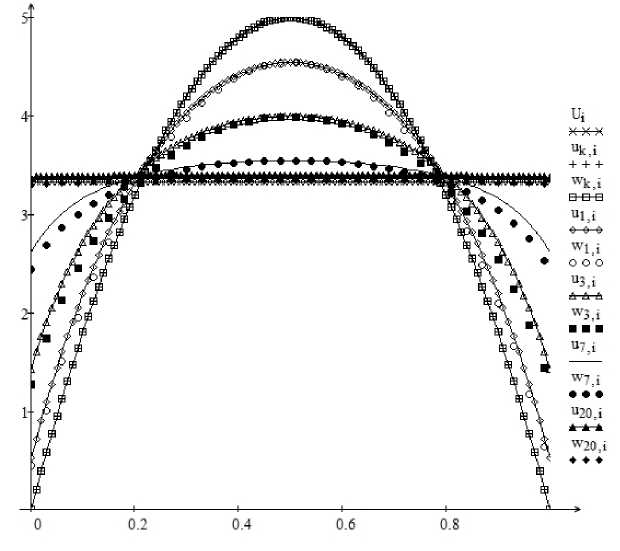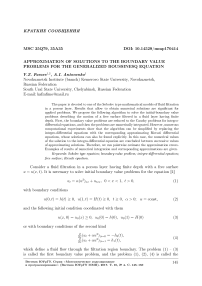Approximation of solutions to the boundary value problems for the generalized Boussinesq equation
Бесплатный доступ
The paper is devoted to one of the Sobolev type mathematical models of fluid filtration in a porous layer. Results that allow to obtain numerical solutions are significant for applied problems. We propose the following algorithm to solve the initial-boundary value problems describing the motion of a free surface filtered in a fluid layer having finite depth. First, the boundary value problems are reduced to the Cauchy problems for integro-differential equations, and then the problems are numerically integrated. However, numerous computational experiments show that the algorithm can be simplified by replacing the integro-differential equations with the corresponding approximating Riccati differential equations, whose solutions can also be found explicitly. In this case, the numerical values of the solution to the integro-differential equation are concluded between successive values of approximating solutions. Therefore, we can pointwise estimate the approximation errors. Examples of results of numerical integration and corresponding approximations are given.
Sobolev type equation, boundary value problem, integro-differential equation, free surface, riccati equation
Короткий адрес: https://sciup.org/147159451
IDR: 147159451 | УДК: 517.95 | DOI: 10.14529/mmp170414
Текст краткого сообщения Approximation of solutions to the boundary value problems for the generalized Boussinesq equation
Consider a fluid filtration in a porous layer having finite depth with a free surface u = u ( x,t ). It is necessary to solve initial boundary value problems for the equation [1]
ut a (u ) xx + utxx, 0 < x < 1 , t > 0,(!)
with boundary conditions
u(0,t) = h(t) > 0, u(1, t) = H(t) > 0, t > 0, a > 0; a = const,(2)
and the following initial condition coordinated with them
u(x, 0) = u0(x) > 0, u0(0) = h(0), u0(1) = H(0)(3)
or with boundary conditions of the second kind
—h o ( t ) , h 1 ( t )
d (ut + au2) x=o = dX (ut + au2) x=1 = which define a fluid flow through the filtration region boundary. The problem (1) - (3) is called the first boundary value problem, and the problem (1), (2), (4) is called the second boundary value problem. The equation (1) is a Sobolev type equation. The initialboundary value problems for analogous equations were investigated in [2-5]. Introduce a function v(x,t) = ut + au2. write the equatkm (1) in the form v — vxx = au2. and invert the operator 1 — Ц2. Then, we have the Cauchy problems for the following integro-differential equations:
ut(x, t) + a • u2(x, t) = a • G G 1(x, £) • u2(£, t)d£ + a • ( — —x)h2 + s^-xH2^) , (Д) sh 1 sh 1 / ut(x, t) + a • u2(x, t)
= a • Gg 2 ( x,£ ) • u 2( £,t ) dy + h о Ch(1 — x ) sh 1
Ch x
+ h 1-rr sh 1
with the initial condition (3), where
g i ( x,£ ) = -i1 sh 1
sh x • sh(1 — £ ) , 0 < x < £, sh £ • sh(1 — x ) , £ < x < 1 ,
G 2 ( xS “.■ I
ch x • ch(1 — £ ) , 0 < x < £, ch £ • ch(1 — x ) ,£ < x < 1
are the Green functions of the corresponding boundary value problems.
If the boundary conditions are stationary, i.e. the functions h ( t ) = h, H ( t ) = H, h 0( t ) = 0 , h 1 ( t ) = 0 are constants, then the solutions to the considered boundary value problems converge to stationary solutions of the considered boundary value problems [6, 7] uniformly with respect to x as t ^ to.
The stationary solutions have the following form:
-
1) U 1( x ) = л/( H 2 — h 2) x + h 2 is the Dupuy parabola,
-
2) U 2 (x ) = J u 0( x ) dx is the law of mass conservation in the case of impermeability of 0
the boundary or zero total flow through the boundaries of the filtration region, respectively for the first and second boundary value problems.
In order to obtain approximate solutions and construct profiles of free surfaces of a filtered fluid, we propose to replace the integro-differential equations (5) and (6) with the approximating Riccati equations
u 1 t + au = aU 2
and
u 2 1 + au 2 — aU 2 ,
respectively. Their solutions that satisfy the initial condition (3) can be found explicitly and have the form:
( ) = u o ( x ) + U n • th( a • U n • t )
u n x, “ 1 + uu^x) • th( a • U n • t )
n = 1 , 2 .
Further, the implementation of this method for specific initial conditions is carried out in the MATHCAD. The free surface profiles form one-parameter family of curves in the plane.
Consider some examples of profile construction using the numerical integration of the equations (5) and (6) in comparison with the graphs of solutions to the corresponding equations (7) and (8), where we can observe a difference in the values of the solutions because of the approximations.
Example 1. Consider the first boundary value problem (1) - (3) for h = 1 and H = 4. Calculation formulas for numerical integration of the equation (5) and the coordinates of points of the function (9) graphs have the form, respectively:
u k +i ,i = u ki - « ^ [ u k,i — ^ ( G i i,j • u 1^
A x )1 - shl1 - i • Д x ) h 2 — sh| i M H 21 • д sh 1 sh 1
W ki =
u 0( i • A x ) + U 1 ,i • th( a • U 1 ,i • k • A t )
where U 1 ,i = ^( H 2 — h 2) • i • A x + h 2 . In this case, if 0 < u 0( x ) < U 1 ( x ), then
w k,i < u k +1 ,i < w k +1 ,i and as an approximate value u k +1 ,i
W ki + W k +1 i
. Graphs of approximate solution to the problem (5),
we can take u k +1 ,i = (7) are shown in Fig. 1.

Fig. 1. Graphs of the solutions to the equations (5) (solid lines) and (7) (dashed lines) with the initial condition u 0( x ) = (3 x — 1)2 + sin 2 nx. The upper curve is a graph of the stationary solution, the lower curve is a graph of the initial function u 0( x ), a = 0 , 8 , A x = 0 , 01 , A t = 0 , 025
Example 2. Consider the second boundary value problem (1), (2), (4). Calculation formulas for numerical integration of the equation (6) have the form:
2 N 2
uk+1 ,i = uki - a uki - G22i,j • ukj j=0
A x )j • A t.
Graphs of approximate solution to the problem (6), (8) are shown in Fig. 2.

Fig. 2. The graphs of the solutions to the equations (6) and (8) with the initial condition u o( x) = — 20( x2 — x). ar id U2 = J u 0( x) dx = 3, 33.... Ax = 0, 01, At = 0, 05
Acknowledgements. The work was supported by Act 211 Government of the Russian Federation, contract No. 02.A03.21.0011.
Список литературы Approximation of solutions to the boundary value problems for the generalized Boussinesq equation
- Дзекцер, Е.С. О движении грунтовых вод со свободной поверхностью/Е.С. Дзекцер, Г.А. Шадрин//Промышленное и гражданское строительство. -1971. -Т. 10. -С. 22-44.
- Sviridyuk, G.A. The Barenblatt -Zheltov -Kochina Model with Additive White Noise in Quasi-Sobolev Spaces//G.A. Sviridyuk, N.A. Manakova/Journal of Computational and Engineering Mathematics. -2016. -V. 3, № 1. -P. 61-67.
- Свиридюк, Г.А. Фазовое пространство задачи Коши -Дирихле для уравнения Осколкова нелинейной фильтрации//Г.А. Свиридюк, Н.А. Манакова/Известия высших учебных заведений. Математика. -2003. -№ 9. -С. 36-41.
- Zamyshlyaeva, A.A. Mathematical Models Based on Boussinesq -Love Equation//A.A. Zamyshlyaeva, E.V. Bychkov, O.N. Tsyplenkova/Applied Mathematical Sciences. -2014. -V. 8, № 110. -P. 5477-5483.
- Свиридюк, Г.А. Одна задача для обобщенного фильтрационного уравнения Буссинеска/Г.А. Свиридюк//Известия высших учебных заведений. Математика. -1989. -№ 2. -С. 55-61.
- Фураев, В.З. О разрешимости краевых задач и задач Коши для обобщенного уравнения Буссинеска в теории нестационарной фильтрации: дис.. канд. физ.-мат. наук/В.З. Фураев. -М.: Ун-т дружбы народов им. П. Лумумбы, 1983.
- Фураев, В.З. О разрешимости в целом первой краевой задачи для обобщенного уравнения Буссинеска/В.З. Фураев//Дифференциальные уравнения. -1983. -Т. 19, № 11. -С. 2014-2015.


